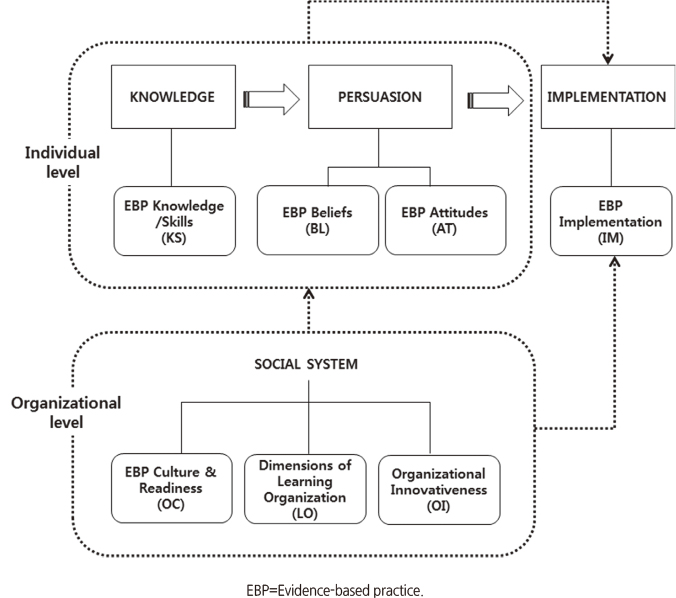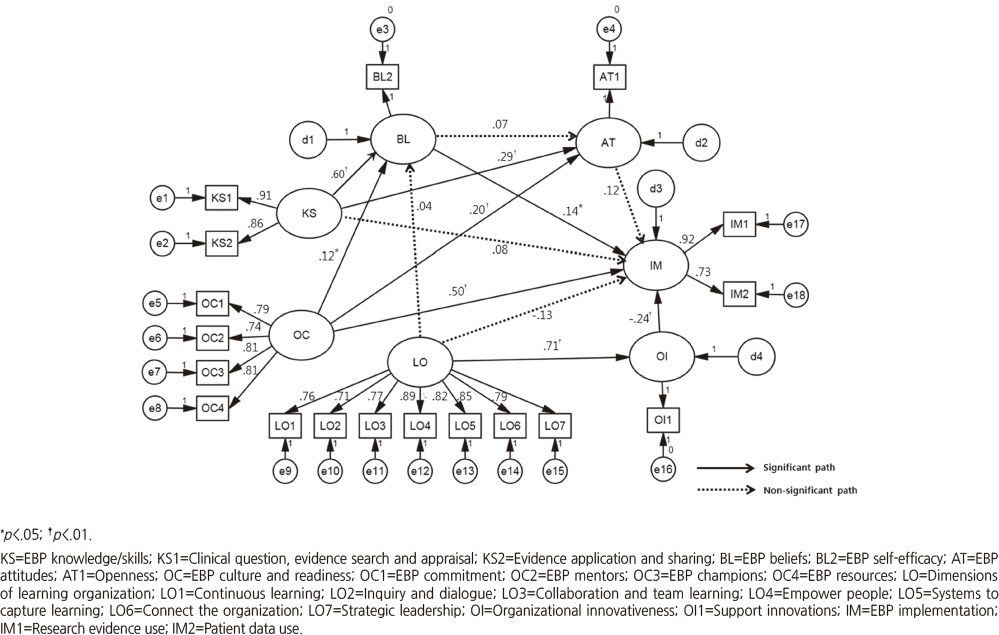J Korean Acad Nurs.
2016 Oct;46(5):697-709. 10.4040/jkan.2016.46.5.697.
Structural Model of Evidence-Based Practice Implementation among Clinical Nurses
- Affiliations
-
- 1Department of Nursing, Honam University, Gwangju, Korea.
- 2College of Nursing, Chonnam National University·Chonnam Research Institute of Nursing Science, Gwangju, Korea. jangks@jnu.ac.kr
- KMID: 2424642
- DOI: http://doi.org/10.4040/jkan.2016.46.5.697
Abstract
- PURPOSE
This study was conducted to develop and test a structural model of evidence-based practice (EBP) implementation among clinical nurses. The model was based on Melnyk and Fineout-Overholt's Advancing Research and Clinical Practice through Close Collaboration model and Rogers' Diffusion of Innovations theory.
METHODS
Participants were 410 nurses recruited from ten different tertiary hospitals in Korea. A structured self-report questionnaire was used to assess EBP knowledge/skills, EBP beliefs, EBP attitudes, organizational culture & readiness for EBP, dimensions of a learning organization and organizational innovativeness. Collected data were analyzed using SPSS/WINdows 20.0 and AMOS 20.0 program.
RESULTS
The modified research model provided a reasonable fit to the data. Clinical nurses' EBP knowledge/skills, EBP beliefs, and the organizational culture & readiness for EBP had statistically significant positive effects on the implementation of EBP. The impact of EBP attitudes was not significant. The dimensions of the learning organization and organizational innovativeness showed statistically significant negative effects on EBP implementation. These variables explained 32.8% of the variance of EBP implementation among clinical nurses.
CONCLUSION
The findings suggest that not only individual nurses' knowledge/skills of and beliefs about EBP but organizational EBP culture should be strengthened to promote clinical nurses' EBP implementation.
Keyword
MeSH Terms
Figure
Reference
-
1. Melnyk BM, Fineout-Overholt E. Evidence-based practice in nursing & healthcare: A guide to best practice. 2nd ed. Philadelphia, PA: Lippincott Williams & Wilkins;2011. p. 1–599.2. Yi J, Park M. Nurses’ access & use of information resources and barriers & competency of evidence based practice. Korean J Adult Nurs. 2011; 23(3):255–266.3. Rogers EM. YS Kim NW Kang HK Park . Diffusion of innovations. 5th ed. New York, NY: The Free Press;2003. p. 1–576.4. Meijers JM, Janssen MA, Cummings GG, Wallin L, Estabrooks CA, Halfens RY. Assessing the relationships between contextual factors and research utilization in nursing: Systematic literature review. J Adv Nurs. 2006; 55(5):622–635. DOI: 10.1111/j.1365-2648.2006.03954.x.5. Melnyk BM, Fineout-Overholt E, Fischbeck Feinstein N, Li H, Small L, Wilcox L, et al. Nurses’ perceived knowledge, beliefs, skills, and needs regarding evidence-based practice: Implications for accelerating the paradigm shift. Worldviews Evid Based Nurs. 2004; 1(3):185–193. DOI: 10.1111/j.1524-475X.2004.04024.x.6. Estrada N. Exploring perceptions of a learning organization by RNs and relationship to EBP beliefs and implementation in the acute care setting. Worldviews Evid Based Nurs. 2009; 6(4):200–209. DOI: 10.1111/j.1741-6787.2009.00161.x.7. Aarons GA, Sommerfeld DH, Walrath-Greene CM. Evidence-based practice implementation: The impact of public versus private sector organization type on organizational support, provider attitudes, and adoption of evidence-based practice. Implement Sci. 2009; 4:83. DOI: 10.1186/1748-5908-4-83.8. Sta. Maria RF, Watkins K. Perception of learning culture and concerns about the innovation on its use: A question of level of analysis. Hum Res Dev Inst. 2003; 6(4):491–508. DOI: 10.1080/13678860210142128.9. Scott SG, Bruce RA. Determinants of innovative behavior: A path model of individual innovation in the workplace. Acad Manage J. 1994; 37(3):580–607. DOI: 10.2307/256701.10. Melnyk BM, Fineout-Overholt E. Putting research into practice, Rochester ARCC. Reflections on Nursing Leadership. 2002; 28(2):22–25.11. Melnyk BM, Fineout-Overholt E, Giggleman M, Cruz R. Correlates among cognitive beliefs, EBP implementation, organizational culture, cohesion and job satisfaction in evidence-based practice mentors from a community hospital system. Nurs Outlook. 2010; 58(6):301–308. DOI: 10.1016/j.outlook.2010.06.002.12. Wallen GR, Mitchell SA, Melnyk B, Fineout-Overholt E, Miller-Davis C, Yates J, et al. Implementing evidence-based practice: Effectiveness of a structured multifaceted mentorship programme. J Adv Nurs. 2010; 66(12):2761–2771. DOI: 10.1111/j.1365-2648.2010.05442.x.13. Thiel L, Ghosh Y. Determining registered nurses’ readiness for evidence-based practice. Worldviews Evid Based Nurs. 2008; 5(4):182–192. DOI: 10.1111/j.1741-6787.2008.00137.x.14. Côté F, Gagnon J, Houme PK, Abdeljelil AB, Gagnon MP. Using the theory of planned behaviour to predict nurses’ intention to integrate research evidence into clinical decision-making. J Adv Nurs. 2012; 68(10):2289–2298. DOI: 10.1111/j.1365-2648.2011.05922.x.15. Koo JM, Song HD. A study on the relationship between creative climate, dimensions of learning organization, and organizational innovativeness: Based on employees of advertising agencies. J Creativity Innov. 2014; 7(2):75–109.16. Ferguson LM, Day RA. Challenges for new nurses in evidence-based practice. J Nurs Manag. 2007; 15(1):107–113. DOI: 10.1111/j.1365-2934.2006.00638.x.17. Bentler PM, Chou CP. Practical issues in structural modeling. Sociol Methods Res. 1987; 16(1):78–117. DOI: 10.1177/0049124187016001004.18. Bae BR. Structural equation modeling with Amos 19: Principles and practice. Seoul: Chungram Books;2011. p. 1–668.19. Melnyk BM, Fineout-Overholt E, Mays MZ. The evidence-based practice beliefs and implementation scales: Psychometric properties of two new instruments. Worldviews Evid Based Nurs. 2008; 5(4):208–216. DOI: 10.1111/j.1741-6787.2008.00126.x.20. Upton D, Upton P. Development of an evidence-based practice questionnaire for nurses. J Adv Nurs. 2006; 53(4):454–458. DOI: 10.1111/j.1365-2648.2006.03739.x.21. Lim KC, Park KO, Kwon JS, Jeong JS, Choe MA, Kim JH, et al. Registered nurses’ knowledge, attitudes, and practice about evidence-based practice at general hospitals in Korea. J Korean Clin Nurs Res. 2011; 17(3):375–387.22. Aarons GA. Mental health provider attitudes toward adoption of evidence-based practice: The evidence-based practice attitude scale (EBPAS). Ment Health Serv Res. 2004; 6(2):61–74. DOI: 10.1023/B:MHSR.0000024351.12294.65.23. Jung EH. A study on the community mental health service provider’s attitude toward adoption of evidence-based practice: Focusing on the effect of leadership. Stud J Soc Welf. 2008; 1:205–227.24. Fineout-Overholt E, Melnyk BM. Organizational culture and readiness for system-wide implementation of EBP (OCR-SIEP) scale. Gilbert, AZ: ARCC llc Publishing;2006.25. Watkins KE, Marsick VJ. Sculpting the learning organization: Lessons in the art and science of systemic change. San Francisco, CA: Jossey-Bass;1993. p. 1–298.26. Yang B, Watkins KE, Marsick VJ. The construct of the learning organization: Dimensions, measurement, and validation. Hum Resour Dev Q. 2004; 15(1):31–55. DOI: 10.1002/hrdq.1086.27. Hurley RF, Hult TM. Innovation, market orientation, and organizational learning: An integration and empirical examination. J Mark. 1998; 62(3):42–54. DOI: 10.2307/1251742.28. Jeon YG. The relationship of transformational leadership to cooperative behavior, creativity, and organizational innovativeness: The moderation of learning orientation: Focused on resort firms in Kang Won province [dissertation]. Gangneung: Kwandong University;2008. 1–146.29. Hu LT, Bentler PM. Cutoff criteria for fit indexes in covariance structure analysis: Conventional criteria versus new alternatives. Struct Equ Modeling. 1999; 6(1):1–55. DOI: 10.1080/10705519909540118.30. Hong S. The criteria for selecting appropriate fit indices in structural equation modeling and their rationales. Korean J Clin Psychol. 2000; 19(1):161–177.31. Chang AM, Crowe L. Validation of scales measuring self-efficacy and outcome expectancy in evidence-based practice. Worldviews Evid Based Nurs. 2011; 8(2):106–115. DOI: 10.1111/j.1741-6787.2011.00215.x.32. Melnyk BM. Strategies for overcoming barriers in implementing evidence-based practice. Pediatr Nurs. 2002; 28(2):159–161.33. Montaño D, Kasprzyk D. Theory of reasoned action, theory of planned behavior, and the integrated behavioral model. In : Glanz K, Rimer BK, Viswanath K, editors. Health behavior: Theory, research, and practice. 5th ed. San Francisco, CA: Jossey-Bass;2015. p. 95–124.34. Kwon JS. Employee’s defensive behavior against organizational innovation. J Bus Res. 2000; 15(2):177–206.35. Sandström B, Borglin G, Nilsson R, Willman A. Promoting the implementation of evidence-based practice: A literature review focusing on the role of nursing leadership. Worldviews Evid Based Nurs. 2011; 8(4):212–223. DOI: 10.1111/j.1741-6787.2011.00216.x.36. Profetto-McGrath J. Critical thinking and evidence-based practice. J Prof Nurs. 2005; 21(6):364–371. DOI: 10.1016/j.profnurs.2005.10.002.37. Ross J. Information literacy for evidence-based practice in perianesthesia nurses: Readiness for evidence-based practice. J Perianesth Nurs. 2010; 25(2):64–70. DOI: 10.1016/j.jopan.2010.01.007.
- Full Text Links
- Actions
-
Cited
- CITED
-
- Close
- Share
- Similar articles
-
- Factors Influencing Nurses' Implementation of Evidence-based Fall Management in Geriatric Hospitals
- Effects of an Evidence-Based Practice (EBP) Education Program on EBP Practice Readiness and EBP Decision Making in Clinical Nurses
- Nurses' Usage of Clinical Practice Guideline and Demand of Evidence Based Clinical Practice Guideline
- Hospital Nurses' Uses of Evidence, and Barriers to and Enablers of Evidenced-based Practice
- Applying Theory Informed Global Trends in a Collaborative Model for Organizational Evidence-based Healthcare



